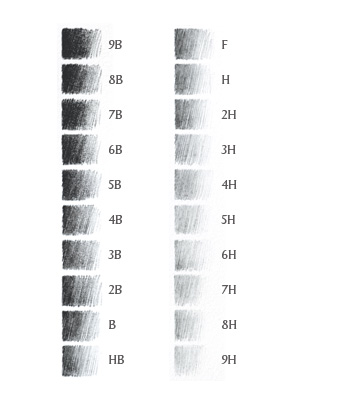Unlock Your Pencil Power: Mastering Pencil Lead Grades
Ever wondered what those mysterious letters and numbers on your pencils mean? They're not just random labels. Understanding pencil lead gradations opens up a world of possibilities, whether you're a seasoned artist, a diligent student, or simply jotting down grocery lists. This guide will delve into the fascinating world of pencil lead hardness, revealing its secrets and empowering you to choose the perfect pencil for every task.
Pencil lead hardness, also known as pencil grade, is a crucial factor determining the darkness and durability of your pencil marks. This seemingly simple characteristic drastically impacts your writing or drawing experience. From the faintest whisper of a hard lead to the bold stroke of a soft one, each grade has its purpose.
The graphite grading scale, a standardized system for categorizing pencil lead hardness variations, ranges from 9H (the hardest) to 9B (the softest), with HB and F falling in between. Harder leads create lighter, finer lines, perfect for precise technical drawings or light sketching, while softer leads produce darker, thicker lines ideal for shading, expressive drawing, and general writing.
The origins of standardized pencil lead hardness can be traced back to the early 19th century, with different countries developing their own systems. Eventually, the HB scale, combined with numerical grades, became widely adopted. The "H" denotes hardness, while the "B" signifies blackness, and the "F" stands for fine point. The numbers preceding the letters indicate the degree of hardness or blackness.
Knowing the properties of different pencil gradations is essential for various applications. For architects, engineers, and drafters, the precise lines of hard leads are indispensable. Artists rely on a range of lead hardness levels, employing harder leads for initial sketches and softer ones for shading and adding depth. Even for everyday writing, understanding lead hardness can enhance your comfort and control.
For instance, a 2H pencil is excellent for technical drawings due to its light, fine lines, while a 4B pencil is ideal for sketching and shading because of its darker, softer marks. An HB pencil is the middle ground, suitable for general writing and note-taking.
One benefit of understanding pencil lead variations is the ability to select the right tool for the job. This ensures optimal results and prevents frustration. Another advantage is the enhanced control over your artistic or writing expression. Finally, knowing the nuances of pencil grades allows for greater precision and detail in your work.
If you are an aspiring artist, start by experimenting with a range of pencil lead hardnesses. Practice sketching with different grades to understand how they perform and what effects they produce. For technical drawing, begin with harder leads like 2H or 4H for precision. For writing, try HB, B, or 2B depending on your preferred line darkness and feel.
Advantages and Disadvantages of Different Pencil Lead Hardnesses
| Lead Grade | Advantages | Disadvantages |
|---|---|---|
| 9H - 4H | Fine lines, clean, resists smudging, ideal for technical drawing | Can be difficult to erase completely, may indent paper, not suitable for shading |
| H - 2H | Good for light sketching, general writing, relatively easy to erase | Not as dark as softer leads, may not be ideal for expressive drawing |
| HB - F | Versatile, good for writing and sketching, relatively smooth | Not as dark as softer grades, not as precise as harder grades |
| B - 2B | Smooth, dark lines, ideal for sketching and shading | Smudges easily, not ideal for precise work |
| 3B - 9B | Very dark, rich lines, excellent for expressive drawing and shading | Smudges very easily, requires fixative, not suitable for writing or technical drawing |
Best Practices:
1. Store pencils properly to prevent lead breakage.
2. Use a quality sharpener for a consistent point.
3. Experiment with different lead grades to find what suits your style.
4. Control your pressure to achieve varying line weights.
5. Consider using a fixative to prevent smudging for softer leads.
FAQ:
1. What does HB stand for? Hard Black.
2. What is the hardest pencil lead? 9H.
3. What is the softest pencil lead? 9B.
4. What pencil lead is best for writing? HB, B, or 2B.
5. What pencil lead is best for sketching? A range from H to 4B.
6. What pencil is best for technical drawing? 2H or harder.
7. Do pencil lead grades affect erasing? Yes, harder leads are easier to erase.
8. Why do my pencils keep breaking? Too much pressure or a dull sharpener.
In conclusion, understanding the nuances of pencil lead hardness is paramount for anyone who uses pencils, whether for artistic endeavors, technical drawings, or everyday writing. The spectrum of lead gradations, from the crisp lines of 9H to the rich darkness of 9B, offers a diverse range of possibilities. By mastering the art of selecting and utilizing the right pencil lead hardness, you can unlock your full creative potential and enhance your overall writing and drawing experience. Explore the different grades, experiment with their unique qualities, and discover the power that lies within the humble pencil. So, grab your pencils and start creating! You might be surprised at the difference the right lead can make in bringing your visions to life. This knowledge will not only improve the quality of your work but also add a new layer of enjoyment to the simple act of putting pencil to paper. By considering the tasks at hand and choosing the appropriate pencil lead, you are setting yourself up for success, whether it be a perfectly rendered drawing or a clearly written note.
The engaging world of dibujo vaca lola animada
F250 rear differential fluid change
Rocking june your ultimate guide to luke combs concerts














